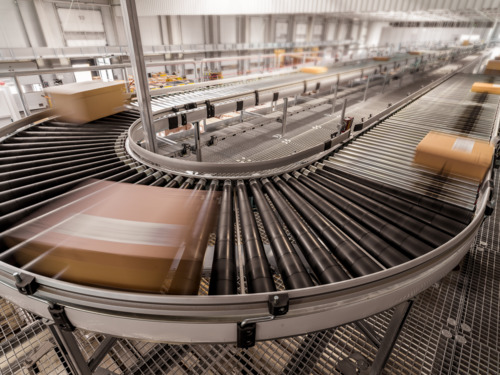Intralogistics specialist TGW has developed an omnichannel formula for future success, based on many years of experience in the food retailing industry. The underlying premise is: Due to the growth in e-commerce, stationary stores need to be restructured.
(Marchtrenk, 23. September 2019) Study evaluations, customer surveys, in-house appraisals: Austrian systems integrator TGW has recently performed a long-term analysis of changes in consumer behavior related to food retailing in term of growing e-commerce. As a result, TGW has now drawn up ten expert tips on how food retail chains can gear up logistically for the future. TGW’s findings in a nut shell: Only those businesses that offer the best possible services to the entire customer spectrum will be able to retain their regular customers as well as win new groups of buyers. “In the face of tough competition, those companies that are realigning their stationary structures and intralogistics based on changing framework conditions will have a competitive edge,” underscores Michael Schedlbauer, industry manager grocery at TGW.

TGW, as an intralogistics provider, has responded to new challenges in food retailing as early as 2018. “Together with the shopfitting specialists from umdasch The Store Makers, we have been working on a comprehensive, innovative shop and logistics concept for food retailers. Our OmniStore strategy combines solutions from both companies,” says Schedlbauer.
The main feature of this concept is the integration of a separate logistics area into existing stores, where goods are stored and online orders are picked by means of automation technology. Only a few minutes after having placed an order, customers can pick up the contents of their virtual shopping cart in their favorite store, or have their purchases delivered. One well-known European retail chain is already working on its first OmniStores. “Although not as many people in countries such as Germany or Austria buy food online as they do in the UK, for example, we are still convinced that this trend will prevail,” says logistics expert Schedlbauer.
10 food retailer life hacks from the experts
1. Restructuring your stationary store
2. Synchronizing your channels
3. Downsizing the sales floor area
4. Focus your product range available in the store
5. Setting up a (partially) automated logistics area
6. Create added value for your customers
7. Increase your services
8. Reducing goods loss
9. Creating diversified jobs
10. Supply chain optimization
Here are the details
1. Restructuring of stationary stores: The underlying idea here is to combine stationary retailing with online channels. Stores are the most important customer channels – and will continue to be so. However, this sales channel must be redesigned such that consumers can use both offline and online services as conveniently as possible, i.e. seamlessy.
2. Synchronizing channels: Customers want to pay the same price for a particular product in the store and online. The product range categories on the web should correspond with the categories in the shop in order to offer the customers ease of orientation. If you create a digital shopping list online, you should also be able to use it in the store and share it with other family members. Customers also expect a variety of payment options.
3. Downsizing the sales floor: This is particularly true for self-service supermarkets. Customers want to shop quickly and at the same time have short distances to go. A smaller sales area gives shoppers a better overview and better orientation.
4. Focus the product range available in the store: Consistent attention should be paid to consumer behavior. The focus should be on fresh regional products. An online product range adds to the "shelf". Some of the items can even be picked within minutes in a separate logistics area.
5. Setting up a partially automated logistics area: Thanks to reduced sales floor space, there is room for a separate logistics area. Here, employees can quickly pick online orders locally thanks to state-of-the-art technology. The result is reduced costs and increased performance. Throughput times of less than ten minutes make it possible for customers who are already in the store to spontaneously order online items and immediately take them with them.

6. Create added value for your customers: A part of the shop ought to be used for appealing hospitality because eating out is the trend. The emphasis here is on social contacts for customers. The stores should also regularly offer promotions such as sampling, showcasing of new products, or special workshops. The workshops should also be held after closing hours. Because long waiting times at the checkout stand are one of the biggest customer complaints about grocery stores, waiting times should be kept to a minimum.
7. Increase services: For fresh products, customers should find a counter with service provided. Online orders are picked by food chain staff, thereby saving time. The delivery of online orders needs to be flexible. Customers want to be able to pick up their ordered items quickly and easily. For the pick-up of merchandise after closing hours, a pick-up station has to be integrated into the exterior wall of the store. If you don't want to or can't pick up your order yourself, you can use home delivery service.
8. Reducing loss of goods: Goods frequently subject to theft need to be stored in a separate logistics area. Thanks to excellent inventory transparency in the logistics area, selling out certain products or spoiled products can be prevented, thereby avoiding losing sales.
9. Creating diversified jobs: Employees can focus more on interacting with customers by having to spend less time on shelving. Picking stations in the logistics area need to be as ergonomic as possible. Many stores employ more elderly people.
10. Supply chain optimization: Software tools allow for improved demand-planning through online ordering. Data Analytics enables food chains to better evaluate and interpret their data. This allows, among other things, for a rapid adjustment of product ranges.

